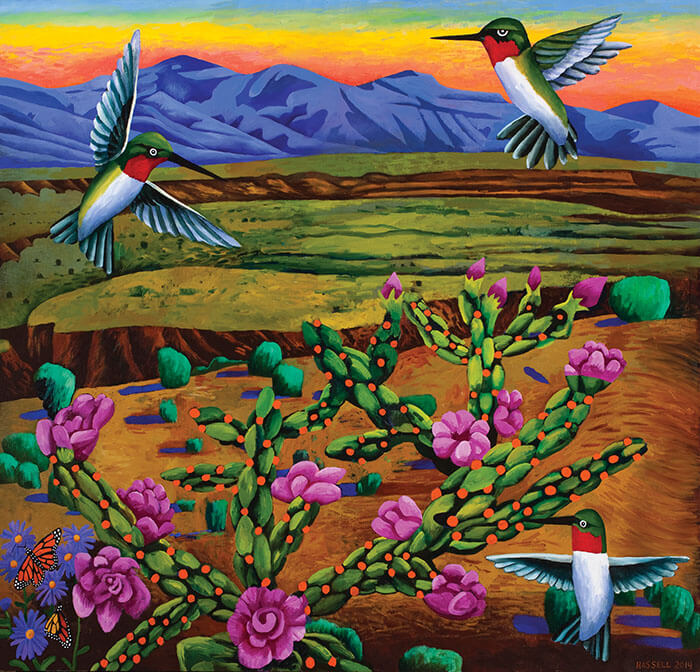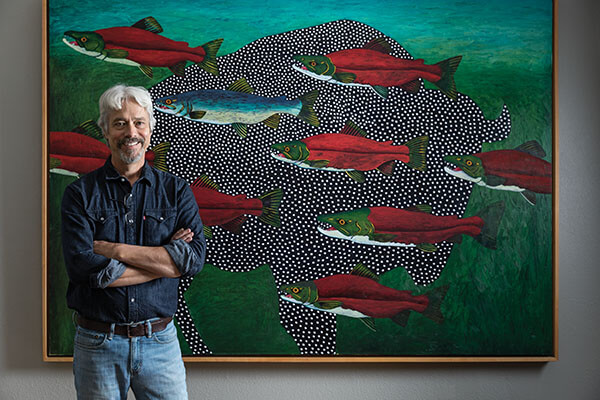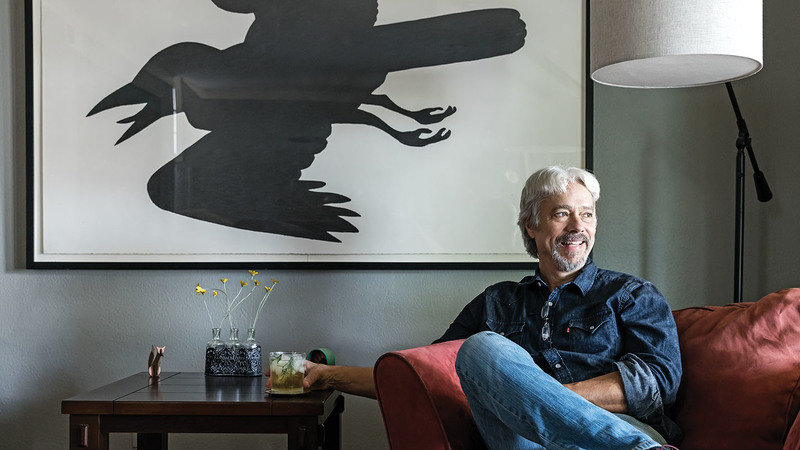Walk into the studio of Billy Hassell ’78 within the Fairmount Historic District of Fort Worth, and the birds practically call out to you, shrieking from canvases vibrant with color.
Between doors guarded by trusty floor fans and under a tin ceiling, which has just been fixed from a classic North Texas storm of only a few nights prior, hangs part of the winged-inspired series for Texas Parks and Wildlife. Or check out the owl, an unfinished piece, staring out from a darkened landscape Hassell found in the Yukon.
Hassell, like the birds he celebrates, has taken flight throughout the United States — in popularity, yes, but also in the personal experiences of his 61 years.
 Billy Hassell, Hummingbirds and Cholla 48” x 50” oil on canvas.
Billy Hassell, Hummingbirds and Cholla 48” x 50” oil on canvas.
“You would think I started out in a rural area since nature is my usual subject,” says the Texas native, who’s taken a seat near a wood burning stove. “But I grew up in Dallas, pretty much in the middle of the city. But it was wilder in those days, and I had access to a really nice creek. When I was 9 or 10, a neighbor of mine would go down to a golf course and collect golf balls and sell them. I went along and noticed these terrific snakes and turtles. I was determined to bring these things back from a creek and set up tanks and tubs. My house backyard was a menagerie that way growing up. It made me feel alive.”
He also felt alive in art, finding an ability there long before he found a comfortable footing in schoolwork. “The art interest began from a young age, too,” says Hassell, whose work is on display at the Modern Art Museum of Fort Worth and the Dallas Museum of Art. “I was always, maybe obsessively, drawing, and my mother figured out she could take me anywhere, and, if I had paper, I would be entertained. I was very preoccupied with my imagination. Going to the Catholic school Cistercian, where I would later teach art, I had Jack Mims as a teacher and he went on to be a well-known artist. I had a good base.”
The base widened when he studied for a fine arts degree at Notre Dame. “College provided much of my appreciation for creating,” he says. “I was surrounded by so many real artists like never before. It was a true community, and they opened my eyes to the bigger world of art history.”
That experience didn’t convince him that he could make a living as an artist, but he knows his confidence in his ability started to take flight there. He learned from many professors, but a triumvirate stands out to this day. “Doug Kinsey taught oil painting and made me much more aware of technique,” he says. “Bill Kremer, who taught sculpture and ceramics, gave me a sense of being free in your work, not always waiting for inspiration but building up momentum and having the inspiration follow. Don Vogl — the teacher I keep most in touch with — taught me not to be afraid to experiment. We both share notes on what we’re working on to this day.”
One boost of encouragement came after graduation, when a piece entered into a competition didn’t win but sold for roughly $250. “It was a watercolor imaginary landscape of fish, stars and was a tall vertical piece with a decorative border,” he says. “I was much more interested in pattern then. My influences to that point I have to partly credit to going to Catholic church and seeing stained glass windows during childhood. It was one of the major things I carried from growing up.”
His wife at that time, a flight attendant, eventually got a job in Boston, and he followed. He couldn’t decide what his focus was — dabbling in oil painting, mosaics and more had his head turned in all directions — but he would stroll the city streets and collect random items, unraveling his treasures to make a portfolio that eventually helped get him into graduate school. “Boston also had a lunchtime lecture series at a contemporary art museum to hear artists talk about their work,” he says. “The Gardner Museum was outstanding. You just had a wealth of what was essentially free.”
And a little free advice would help change the course of his career.
At a party, Hassell ran into Paul Nagano, then the director of a gallery on Newbury Street. “I told him I did art, and he said he wanted to see my work. I didn’t feel I was ready, but the more reticent I was, the more he wanted me to at least show him. I ended up going down there with about 10 pieces — two or three were mosaics, a couple watercolors.”
After Nagano looked at them, says Hassell, “[He] gave me some of the most important advice I’d ever received to that point in my life. He said sometimes in life you have to make choices, decide what’s most important and pursue that. He was talking about picking the medium. Until you do that, he said, you might think you’re keeping your options open but, in reality, you’re a prisoner of your own indecision.
“I think I began to take that advice right away. I think that was the beginning of deciding to be a painter.”
Hassell would go on to receive his MFA in studio art from the University of Massachusetts in 1982, partly in the hopes of landing a professorship, but it was landing in Houston that truly began the launch of his career.
“Many of my friends had ventured to New York, where so many top galleries were,” he says. “Some succeeded, but many had a bad experience. It wasn’t for me — I thought there were so many places to experience being an artist and finding a potential audience.”
So it was back to Texas, where his wife had found an opportunity in Houston dealing in the arts and he found his own working at a gallery. “It had great 19th century work — there I am handling a Winslow Homer!” he says. “I was learning the gallery’s point of view, what their business challenges are, and that actually helps me today to be helpful to them as an artist. It also turned out it was a great time to be there because an arts community was growing and I would get to latch on to it.”
In fact, a few examples of his work in his wife’s office led to another stroke of good fortune. “One of the board members of the cultural arts council saw my work and brought her dealer over to my house to look at more stuff, offering to rep my work immediately,” he says. “Think about it — within a month or two of moving to Houston, I got job at a gallery and got picked up by a gallery. They gave me a few months to have enough work to show, and the show pretty much sold out.”
Pieces selling from roughly $600 to $2,500 in that time, it also put some much-needed money in his pocket.

From there his work took off. “I got offers to do large corporate commissions, and when I got the second commission we decided we could risk me quitting the day job to become a full-time artist.” Getting picked up by a reputable gallery in Soho also meant that he found a way to New York after all. “You could wonder if you did the wrong thing by not going there . . . that gallery opportunity would have put any potential feelings about that aside.”
But his painting career, while not put aside, did share space with teaching art in the latter part of the 1980s — including a brief semester’s sojourn to his alma mater. “With some teachers I knew on hiatus, it gave me a chance to have the Notre Dame experience from a different point of view,” he says. “I taught etching and water medium. It was fun to be back and have it come full circle at Notre Dame. There is always a sense of culture and ideas brewing when you’re there. To possibly inspire Notre Dame students like I once was, it just felt like an experience that was meant to be. But I’m one of those people who often looks at things as not just being chance.”
During the year he taught at Davidson College in North Carolina, ARTnews released an issue in which critics around the country named artists who showed promise. A Dallas-area critic chose Hassell. “Back then, this was one of a few magazines where getting into it could make an unbelievable difference,” he says. “To get that recognition on a national level opened me up to new opportunities.”
Returning to Texas, somewhat the artistic version of the conquering hero, he was now well on the map in his field. But, when the next move out of the state occurred, it was made only by one. “Our marriage did ultimately end, but the good thing is that we remain amicable,” he says. “I stayed behind in Fort Worth.” Where he remains to this day, with his studio a comfortable commute from his house just a few blocks away. A place known as Cowtown, where a good steak is as common to the area as a loyal pickup truck. But, for most, it’s just home — and Hassell seems quite at ease here. So, too, do his dogs, who come bustling in to the studio during our conversation. One gives me a friendly lick while his wife, Emily, whom he married in 2013, holds on to the other, sweetly calling the first one back. She’s off to take these midsized dogs to their vet appointment.
Hassell speaks proudly of his two adult children. “My daughter [who is an art teacher] even was once making use of another room in the studio,” he says. “Life takes unexpected turns — it’s taken me to a very good place.”
In living color
After we sit for a while to talk about the trajectory which has led to his present standing, we get to standing ourselves, taking in some of his latest works, nature coming alive in spirited color.
His work today is not quite realism, because he leaves it open to adding colors and shapes that aren’t necessarily in the scene he’s depicting. “I like things logical enough to be believable but that give way for imagination,” he says. One of his oil paintings, he notes, “came from a friend inviting me up to his ranch up in Colorado. The mountain range is real, but a lot of what I’ve added just comes from imagination. I want the colors to come alive for me, and I don’t want to hold back.”
Most pieces he creates are for selling, not letting sentimentality eat into the potential till too much. But a few works that didn’t initially find a buyer likely will remain his. “That picture of a wolf that is simple but of a folk-art style,” he says, “it reminds me of where I’ve come from, so I don’t think I’d let it go. That simple picture of a skunk from my first show — I’ve had offers but, again, it’s a reminder.”
His inspiration arrives in many ways, such as a trip by canoe in Arkansas led by a guide. He’s hoping his planned excursion later this year to the Missouri River might follow suit. “Sometimes there just isn’t time to stop, but I have my sketch book with me,” he says, adding, “Some of the strategy in my work is to simplify things for depiction’s sake and then completely invent the color. I do more invention with color than with anything else.”
The subject matter still stays within nature, but it has evolved, he says, from a raw folk-art influence to more refined. “I think this [evolving] partly started from being involved with The Nature Conservancy of Texas in the ’90s,” he says. “They commissioned me to do a piece about the Edwards Plateau area in Austin, especially focusing on the endangered animals in that area. I was later recommended to Audubon Texas around 2000 to do a five-year project of five lithographs,” which featured such birds as egrets, golden-cheeked warblers and cedar waxwings.
“What I thought was a sideline project became more in the center of what I was interested in as an artist. I became more literal in subject matter and more specific in the species I focused on, where you could more easily identify their characteristics.”
The placement of one work may even have showcased his talent to more eyes than in just about any other venue. If you happen to find your travels involving Dallas-Fort Worth International Airport, head over to Terminal D to find a floor space holding Hassell’s 20-foot diameter bird mosaic medallion, Early Morning Flight. For countless road warriors trudging through the airport, this apt title and vibrant artwork may offer a welcome artistic breather.
It’s okay to mean business
William Campbell has seen a bit of Fort Worth art in his day. As co-owner and president of William Campbell Contemporary Art, a local gallery that has been around for the good part of half a century, he’s observed local tastes change. What he hasn’t seen is Billy Hassell go into a sales drought in his establishment.
“There’s a reason for it,” Campbell says. “He is so professional and never makes you wait on him the way some artists do. He’s out at other artists’ events; he’s approachable. He brings such a respect for the art community. The other side is that he has his own style, something not so easy to acquire. And he also has a subject where he finds new ways to express it.”
Campbell recalls how Hassell’s last show at his gallery held 30 pieces, all of which were snapped up. “You get excited when he has work ready,” he says. “He’s a staple of Fort Worth art.”
Today, the artist’s larger pieces have fetched as much as $40,000. While Hassell certainly didn’t get into this solely for the money, he will admit to parting ways with people who believe artists have to be starving to “earn their keep.”
“Of course, sometimes an artist’s business can suffer just from a lack of experience,” he says. “I remember pricing so low back in Houston in the ’80s. They wanted to up my price in New York, and I was afraid I’d price myself out of having local customers. You learn that it’s okay to take a chance, that there might even be a new group to purchase your work.”
He realizes, however, that “many artists get uncomfortable with the business aspect, like they’re doing something that’s wrong by even thinking about it. We work hard, and it’s okay for us to make a decent living at this. I’m very thankful it’s allowed me that chance.”
Nancy Whitenack, owner and director of Conduit Gallery in Dallas, says Hassell helps himself by being in step with the times. “He fits in well with how art interests have changed in our area because it became much more contemporary,” she says. “Even though his work is in nature, it still has that contemporary feel that shines through in its delivery . . . it also attracts buyers since it showcases Texas through the locations he picks.”
Hassell also believes it’s a business advantage that he enjoys talking to people about his work and doesn’t mind sharing his art philosophies. “Many artists are very introverted, but I really like interacting and it’s fun to hear about what drew someone to something I worked on, or there might be a story I can relate to them about how it came to be,” he says. “There can be a social component to being an artist — it doesn’t all have to be time spent in your head, all alone painting.”
Despite his welcoming nature, Hassell requires his alone time. He does his share of “hiding out” in his studio, which, when the doors are open, can offer the sounds of children laughing and playing at an elementary school just down the road.
“I feel relaxed here after I lived in so many cities,” he says. “I think moving can make you tired after a while — and I still feel there are many strong paintings ahead of me. I think the calm attitude here has helped.”
Still, he admits his works might get a bit smaller as the number of birthday candles grows. “Most of us are toting our own works around, so the large canvases of paintings can become too much,” he says. “I could get an assistant, many of my colleagues have them, but, you know, I love working on my own, I love the freedom.”
As I leave his studio after our Tuesday afternoon visit, birds’ eyes following me, I consider that maybe Hassell chose this particular living subject as his greatest work partner partly because of the freedom birds project, mirroring the freedom he displays in the imagination he uses, the pace he won’t be pressured to change and the openness when it comes to sharing his creations with others.
“The Inca believed the hummingbird was a warrior, and the bird has a spirit that has been marveled [at] forever, to the point where I just keep coming back to them . . . or maybe,” he said with a laugh that afternoon, “they keep coming back to me.”
Eric Butterman has profiled Regis Philbin ’53, Margaret Ruffing Morris ’98 and others for this magazine. Contact him at ericbutterman@yahoo.com.
